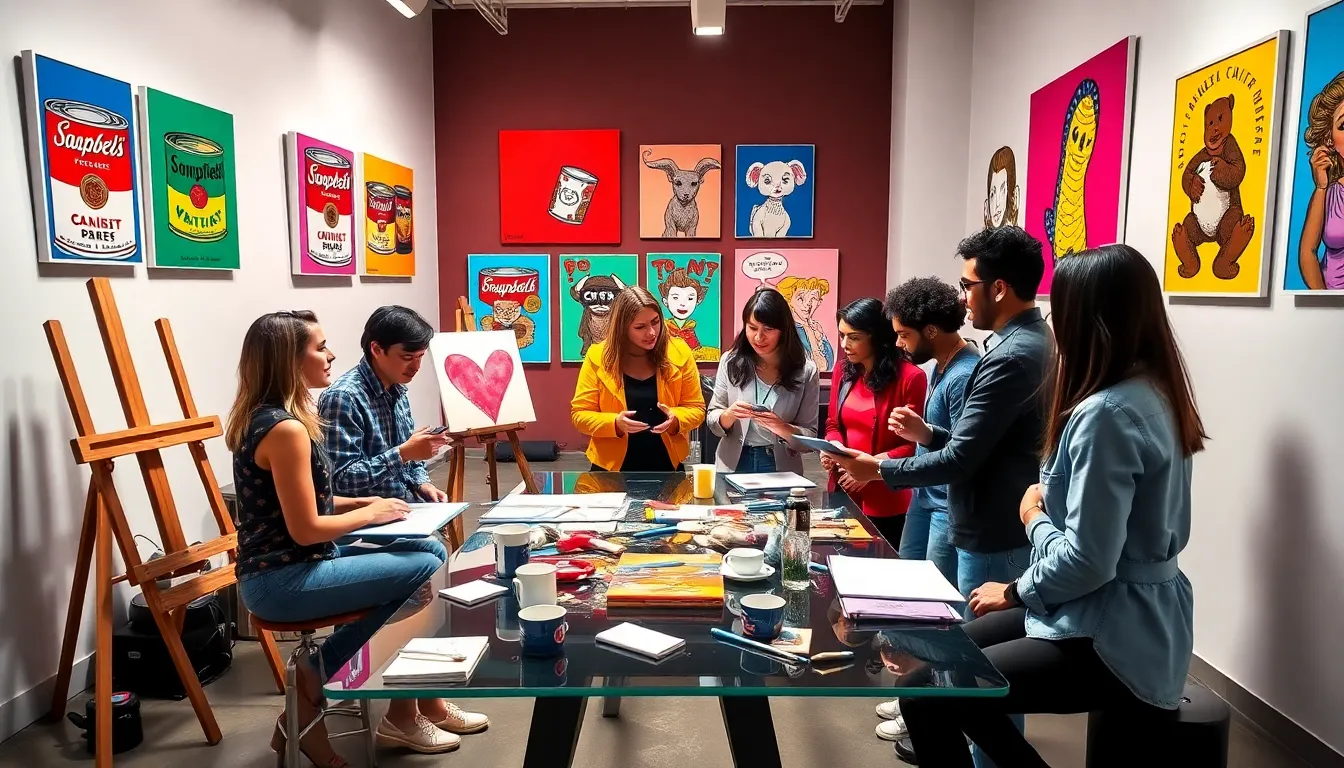Table of Contents
ToggleWhen it comes to art, few movements have sparked as much debate and conversation as pop art. Picture this: your bedroom wall adorned with vibrant Campbell’s soup cans or comic strips, transforming everyday objects into high art. The pop art movement isn’t just about striking visuals: it’s a cultural phenomenon that extends into literature, reshaping how individuals view and appreciate art in everyday life. In this text, we’ll dive deep into the vivid world of pop art books culture. Get ready to discover how pop art transcended the canvas and made its way into the pages of literature, igniting the imaginations of countless readers, and perhaps even inspiring a chuckle or two along the way.
An Overview of Pop Art Movement

Pop art emerged in the mid-20th century as a rebellion against traditional fine art. It was a vibrant art movement characterized by its playful take on consumerism and mass media. Artists like Andy Warhol and Roy Lichtenstein utilized commercial imagery and themes, bringing them into the realm of fine art. The goal? To blur the lines between ‘high’ and ‘low’ culture. This movement challenged societal norms, encouraging viewers to find beauty in the mundane. By tapping into the culture of mass production, pop art turned everyday objects into icons, demonstrating that art can be found anywhere, from cereal boxes to movie posters.
With its roots deeply embedded in the socio-political climate of post-war America, pop art quickly gained momentum. It became a way for artists to express their views on consumer culture and the changing landscape of society. So, the pop art movement established itself not just as an artistic trend but as a cultural dialogue that continues to resonate today.
The Evolution of Pop Art Literature
Pop art literature serves as an intriguing counterpart to the visual movement. Initially, narratives surrounding pop art were primarily found in critiques and analyses. Art critics and scholars sought to define and scrutinize the implications of this radical movement. But, as time progressed, literature began to mirror the pop art ethos, pushing boundaries and challenging conventions.
Books became creative works that celebrated, critiqued, and explored pop culture. Novels, essays, and even graphic novels emerged, influenced by pop art’s distinct aesthetic and philosophies. Authors experimented with various forms, incorporating the bold colors, humor, and irony that defined pop art. In this way, literature became a canvas of its own, inviting readers to engage in the dialogues initiated by visual artists.
Key Influences on Pop Art Books
Several factors contributed to shaping pop art literature, with a few notable influencers standing out. One significant influence was the explosion of consumer culture that began in the post-World War II era. As society became increasingly defined by consumption, books reflected this shift, drawing on the bright colors and bold themes of advertisers.
Also, the rise of mass media played a crucial role in shaping pop art’s literary scene. Television, advertising, and comic books not only provided inspiration but also contributed to the creation of a universal language that transcended geographical barriers. Authors like Tom Wolfe and Kurt Vonnegut tapped into these influences, crafting narratives that mirrored the absurdities and quirks of popular culture, so bridging the gap between fine art and the mainstream.
Notable Pop Art Books and Authors
When discussing pop art literature, certain names stand out as pivotal to its development. One cannot mention this genre without highlighting the work of Andy Warhol. Not only a visual artist, Warhol authored seminal works such as “The Philosophy of Andy Warhol: From A to B and Back Again,” which dissected his thoughts on fame, art, and consumerism with a pop-infused twist.
Another notable figure is Richard Hamilton, whose books and essays provided insights into the intersection of fine art and pop culture. His influential essays like “Just What Is It That Makes Today’s Homes So Different, So Appealing?” helped lay the groundwork for the discussions that would thrive in literature.
Also, contemporary authors are continuing to redefine the genre. Writers like David Foster Wallace merge the humor of pop art with profound existential questions, creating narratives that resonate with a wide audience.
Eventually, these authors and their works have propelled pop art literature into a distinct realm, enriching the cultural landscape.
The Intersection of Pop Art and Other Media
Pop art’s impact isn’t limited to the visual arts or literature: it also permeates various other media. Films, music, and even fashion channels the vibrant ethos of pop art. Movies like “The Graduate” and “Moonrise Kingdom” visually incorporate pop aesthetics, making the art style an integral part of their narratives.
In the music world, pop art can be seen in the groundbreaking work of musicians like David Bowie and Madonna, whose personas often reflect pop art characteristics, daring, playful, and exaggerated. These artists embraced the primal colors and irony of the movement, translating it into a different form of expression.
Besides, fashion designers such as Pierre Cardin and Jean-Charles de Castelbajac have successfully melded pop art into wearable art, showcasing pieces that resemble famous paintings or embody the movement’s essence. By interlinking with various media, pop art continues to shape cultural production across platforms.
Impact of Pop Art on Contemporary Culture
The influence of pop art on contemporary culture is both profound and pervasive. It has laid the foundation for what we now recognize as modern graphic design, advertising, and even social media trends. The iconic imagery associated with pop art has permeated contemporary branding, allowing companies to harness its appeal to attract consumers.
Also, the resurgence of retro aesthetics in today’s fashion and design echoes pop art’s colorful approach. Vintage-inspired goods and designs appeal to a nostalgic audience, blending traditional styles with modern flair. Many artists today draw inspiration from pop art techniques, pushing visual boundaries and creating dialogues that resonate with younger generations.
As a cultural phenomenon, pop art has shifted paradigms, prompting society to rethink its relationship with art. The appreciation of the playful and everyday continues to foster groundbreaking creativity and innovative expressions across disciplines.




